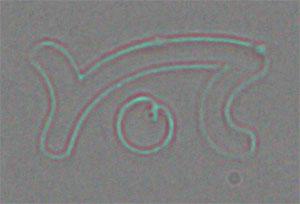Nanolithography and Nanomanipulation
Atomic force microscopes can not only be used to measure surface topography and various material properties of samples. In addition to imaging and single point measurements, the AFM cantilever/probe can be used to actually write onto a surface, be it by a subtractive technique like etching/scratching or an additive technique. It is also possible to manipulate sample features on the nanoscale. Typically operated in static mode, the cantilever/probe can carve out patterns or structures on surfaces through an aggressive interaction between the tip and sample configured with a high deflection setpoint. In this way a stiff cantilever was used to scratch an "X" into the sample below.

The probe can also write structures and patterns through local oxidation at the point between the probe and the sample. In the example below, a Nanosurf logo was etched using local oxidation of titanium by applying 3 V between the sample and a conductive diamond tip.

In terms of manipulation, the probe can be used to cut or move around structures. In the example below, the probe performed a "surgery" on a bacteria (the elongated white structure in both images below) and divided it into two parts. The cut through the bacteria is evident.


More advanced setups such as the Flex-FPM — which uses FluidFM™ with hollow cantilevers connected to a microfluidics control system — can also be used in lithographic mode to write or deposit molecules from a liquid that can be delivered to the surface through the hollow cantilever. The volumes involved are tiny (femtoliters) and are combined with micrometer accuracy to write fluidic patterns such as the ones shown below. On the left is a grid written in biomolecules as a function of application time and pressure steps, resulting in well-controlled spots of different sizes. On the right is the Nanosurf logo written in air with a solution of 50% glycerol and a back pressure of 200mbar.


In this way DNA and RNA has been spotted on a surface for single cell content analysis. With its hollow probes, FluidFM is a more versatile technology than just a tool for spotting and nanolithography. A FluidFM probe exhibiting an opening next to apex of the tip can be used as a syringe for single cell injection or extraction.